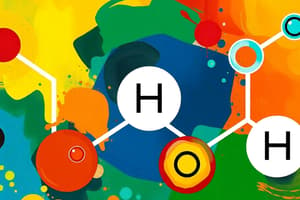Podcast
Questions and Answers
Which functional group is characteristic of carboxylic acids?
Which functional group is characteristic of carboxylic acids?
- -OH
- -COOH (correct)
- -NH2
- -SH
Which class of organic compounds does not contain any double or triple bonds?
Which class of organic compounds does not contain any double or triple bonds?
- Alkenes
- Alkanes (correct)
- Arenes
- Alkynes
What type of isomerism occurs when compounds have the same molecular formula but differ in the connectivity of their atoms?
What type of isomerism occurs when compounds have the same molecular formula but differ in the connectivity of their atoms?
- Optical isomerism
- Stereoisomerism
- Geometric isomerism
- Constitutional isomerism (correct)
Which reaction type involves the transformation of a single reactant into two or more products?
Which reaction type involves the transformation of a single reactant into two or more products?
Which spectroscopy technique is most useful for identifying functional groups in a compound?
Which spectroscopy technique is most useful for identifying functional groups in a compound?
Flashcards are hidden until you start studying
Study Notes
Organic Chemistry Overview
- Definition: Study of carbon-containing compounds, including their structure, properties, reactions, and synthesis.
- Key Elements: Primarily carbon (C), hydrogen (H), oxygen (O), nitrogen (N), sulfur (S), and phosphorus (P).
Structure of Organic Compounds
- Functional Groups: Specific groups of atoms that determine the characteristics and reactivity of organic molecules.
- Common groups:
- Hydroxyl (-OH)
- Carbonyl (C=O)
- Carboxyl (-COOH)
- Amino (-NH2)
- Sulfhydryl (-SH)
- Common groups:
- Isomerism: Compounds with the same molecular formula but different structures.
- Types:
- Constitutional isomers
- Stereoisomers (geometric and optical)
- Types:
Major Classes of Organic Compounds
- Alkanes
- Saturated hydrocarbons (only single bonds)
- General formula: CnH2n+2
- Alkenes
- Unsaturated hydrocarbons (at least one double bond)
- General formula: CnH2n
- Alkynes
- Unsaturated hydrocarbons (at least one triple bond)
- General formula: CnH2n-2
- Arenes (Aromatic Compounds)
- Contain benzene rings; follow Huckel's rule (4n + 2 π electrons).
Reaction Mechanisms
- Types of Reactions:
- Addition reactions (e.g., hydrogenation)
- Substitution reactions (e.g., nucleophilic substitution)
- Elimination reactions (e.g., dehydrohalogenation)
- Rearrangement reactions (e.g., carbocation rearrangements)
Synthesis and Functionality
- Synthetic Strategies:
- Retrosynthetic analysis: breaking down complex molecules into simpler precursors.
- Protecting groups: temporary modifications to prevent undesired reactions.
- Natural Products: Compounds produced by living organisms, significant for pharmaceuticals and biochemistry (e.g., alkaloids, terpenes).
Spectroscopy and Analysis
- Techniques:
- NMR (Nuclear Magnetic Resonance): Determines the structure using magnetic properties of nuclei.
- IR (Infrared Spectroscopy): Identifies functional groups based on absorption of infrared light.
- Mass Spectrometry: Analyzes molecular mass and structure through ionization and fragmentation.
Important Concepts
- Hybridization: Mixing of atomic orbitals to form new hybrid orbitals (e.g., sp3, sp2, sp).
- Resonance: Delocalization of electrons in a molecule, providing stability (e.g., in benzene).
- Acidity and Basicity: Organic acids and bases, influenced by functional groups (e.g., carboxylic acids are typically more acidic than alcohols).
Practical Applications
- Pharmaceuticals: Design and synthesis of drugs.
- Agriculture: Development of pesticides and fertilizers.
- Materials Science: Creation of polymers and other materials.
Organic Chemistry Overview
- The study of carbon-containing compounds and their properties, reactions, and synthesis.
- Key elements in organic compounds include carbon, hydrogen, oxygen, nitrogen, sulfur, and phosphorus.
Structure of Organic Compounds
- Functional groups are specific groups of atoms that determine the characteristics of organic molecules.
- Examples: hydroxyl (-OH), carbonyl (C=O), carboxyl (-COOH), amino (-NH2), and sulfhydryl (-SH).
- Isomerism occurs when compounds have the same molecular formula but different structural arrangements.
- Types: constitutional isomers (different connectivity) and stereoisomers (same connectivity, different spatial arrangement).
Major Classes of Organic Compounds
- Alkanes:
- Saturated hydrocarbons with only single bonds.
- General formula: CnH2n+2
- Alkenes:
- Unsaturated hydrocarbons with at least one double bond.
- General formula: CnH2n
- Alkynes:
- Unsaturated hydrocarbons with at least one triple bond.
- General formula: CnH2n-2
- Arenes (Aromatic Compounds):
- Contain benzene rings, which follow Huckel's rule (4n + 2 π electrons) for aromaticity.
Reaction Mechanisms
- Addition Reactions: Combine two molecules to form a larger one (e.g., hydrogenation).
- Substitution Reactions: One atom or group is replaced by another (e.g., nucleophilic substitution).
- Elimination Reactions: Form a new double or triple bond by removing atoms (e.g., dehydrohalogenation).
- Rearrangement Reactions: Change the structure of a molecule, often involving carbocations.
Synthesis and Functionality
- Synthetic Strategies:
- Retrosynthetic Analysis: Breaking down complex molecules into simpler starting materials.
- Protecting Groups: Temporary modifications to prevent unwanted reactions during multi-step synthesis.
- Natural Products:
- Compounds produced by living organisms, often with significant biological activity and applications in pharmaceuticals and biochemistry.
Spectroscopy and Analysis
- NMR (Nuclear Magnetic Resonance):
- Determines the structure of molecules by analyzing the magnetic properties of their nuclei.
- IR (Infrared Spectroscopy):
- Identifies functional groups by their characteristic absorption of infrared light.
- Mass Spectrometry:
- Analyzes the molecular mass and structure of molecules through ionization and fragmentation.
Important Concepts
- Hybridization:
- Mixing of atomic orbitals to form new hybrid orbitals with different shapes and properties (e.g., sp3, sp2, sp).
- Resonance:
- Delocalization of electrons in a molecule, which contributes to its stability.
- Acidity and Basicity:
- Organic acids and bases, influenced by the presence of functional groups (e.g., carboxylic acids are generally more acidic than alcohols).
Practical Applications
- Pharmaceuticals: Design and synthesis of drugs.
- Agriculture: Development of pesticides and fertilizers.
- Materials Science: Creation of polymers and other advanced materials.
Studying That Suits You
Use AI to generate personalized quizzes and flashcards to suit your learning preferences.




